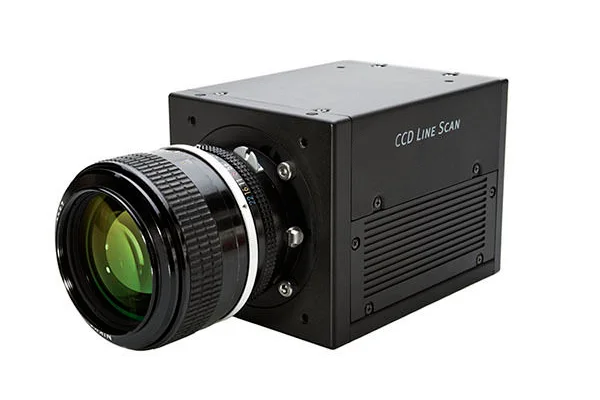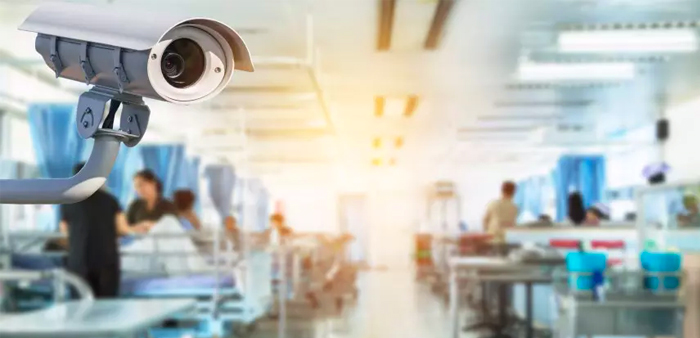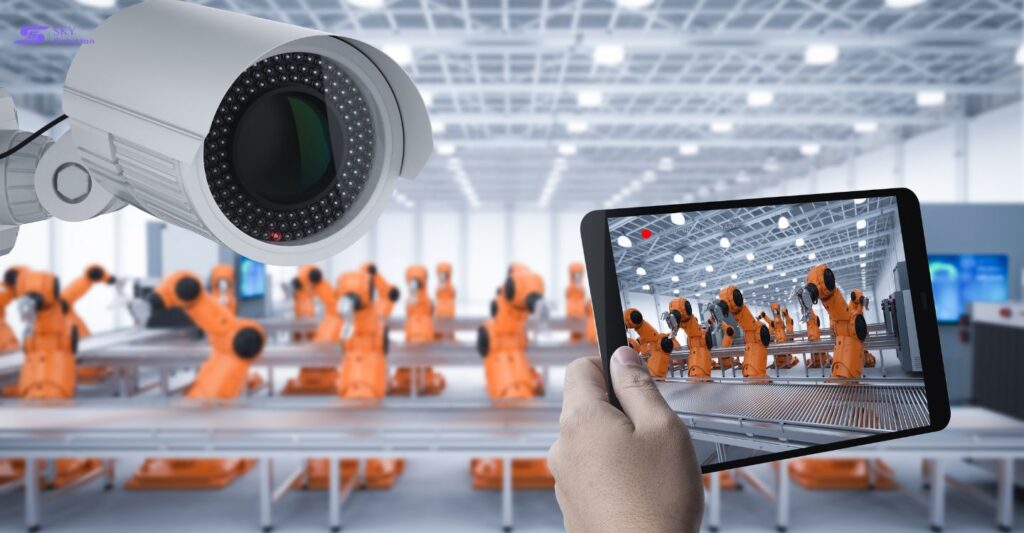Computer vision cameras are transforming automation and quality control by enabling smarter, faster, and more accurate visual analysis across industries. As the global market surges toward $46.96 billion by 2030, these advanced imaging systems have become indispensable for businesses seeking operational excellence. Understanding the capabilities and applications of different computer vision cameras is key to making strategic, future-proof investments. Let’s explore computer vision cameras together in this article!
What is a Computer Vision Camera?
A computer vision camera is a specialized imaging system that combines advanced hardware with sophisticated algorithms to analyze and interpret visual data in real-time. Unlike conventional cameras that simply capture images, these systems use artificial intelligence and machine learning to extract actionable insights from visual information, enabling automated decision-making and process optimization.
Computer vision cameras integrate three fundamental components that work in harmony to deliver intelligent visual analysis. The acquisition system captures high-quality images or video streams using specialized sensors and optics designed for specific applications. The processing engine applies advanced algorithms, including deep learning and neural networks, to analyze the captured data and identify patterns, objects, or anomalies. Finally, the analysis framework converts raw visual information into structured data that can trigger automated responses or inform business intelligence systems.
Key Features to Consider when Choosing a Computer Vision Camera
Selecting the right computer vision camera requires evaluating these critical features to match operational needs:
- Real-Time Processing: Supports immediate response in applications like manufacturing and robotics, where latency may compromise safety or efficiency.
- Resolution & Sensor Quality: Higher resolution increases detection accuracy but demands more processing power. Choose the right sensor (CMOS vs. CCD) based on speed and quality requirements.
- Environmental Durability: Cameras must withstand temperature variations, vibration, dust, and lighting changes, often requiring IP-rated industrial enclosures.
- System Integration & Connectivity: Ensure compatibility with vision software, flexible mounting options, and support for common interfaces (Ethernet, USB, wireless, PoE) for seamless deployment.
- AI-Powered Motion Detection: Reduces false alarms by distinguishing between significant events and irrelevant movements or lighting shifts.
- Frame Rate & Processing Speed: Crucial for tracking fast-moving objects or real-time inspection tasks without image degradation.
Top 6 Types of Computer Vision Cameras
Understanding the distinct characteristics and optimal use cases for different computer vision camera types is essential for selecting the right technology for specific applications. Each camera type offers unique advantages that make it suitable for particular operational requirements.
1. RGB Cameras – Standard Color Vision
RGB cameras capture images in the visible light spectrum, processing red, green, and blue wavelengths between 400 to 700 nanometers. These systems provide human-like vision capabilities, making them ideal for applications where color information is critical for accurate analysis and decision-making.
The primary strength of RGB cameras lies in their ability to perform object detection, instance segmentation, and pose estimation tasks with high accuracy. Their familiar color representation makes them particularly effective for applications involving product identification, brand recognition, and visual quality assessment, where color consistency is paramount.
Manufacturing environments frequently deploy RGB cameras for inspecting products where color variations indicate defects or quality issues. Retail applications leverage these systems for inventory management and customer behavior analysis, while security implementations use RGB cameras for facial recognition and access control systems.
Advanced RGB cameras incorporate sophisticated image processing algorithms that can compensate for varying lighting conditions, ensuring consistent color reproduction across different operational environments. This capability proves essential for applications requiring precise color matching or quality control based on visual appearance.
2. RGB-D Cameras – Depth Sensing
RGB-D cameras combine traditional color imaging with depth sensing capabilities, providing three-dimensional spatial information that enables more sophisticated analysis. These systems capture both visual appearance and geometric properties, making them invaluable for applications requiring precise spatial understanding.
The depth sensing component allows these cameras to measure distances accurately and create detailed 3D representations of objects and environments. This capability proves essential for applications such as robotic guidance, where precise positioning and orientation information is critical for successful task execution.
Virtual try-on systems in retail environments demonstrate the practical value of RGB-D cameras, where the technology captures customer body measurements and proportions to digitally overlay clothing with accurate fit visualization. Industrial applications include bin picking, where robots must identify and grasp objects in complex, three-dimensional arrangements.
Modern RGB-D cameras utilize various depth sensing technologies, including structured light projection, time-of-flight measurement, and stereo vision systems. Each approach offers specific advantages for different applications, with structured light providing high accuracy for close-range measurements and time-of-flight systems excelling in dynamic environments.

3. Multispectral Cameras – Multi-Wavelength Imaging
Multispectral cameras capture images across multiple specific wavelength bands beyond visible light, including near-infrared (NIR) and ultraviolet (UV). This allows for analysis of material properties, plant health, or surface composition that RGB cameras cannot detect.
These systems use specialized filters or sensor arrays to record distinct spectral bands, enabling applications like vegetation monitoring, food inspection, and medical diagnostics. In agriculture, for instance, multispectral cameras help detect crop stress and diseases using vegetation indices such as NDVI.
Multispectral data can be processed with AI-powered computer vision algorithms to classify materials, detect anomalies, and automate decision-making. As industries demand deeper insights beyond color, multispectral cameras are becoming essential in precision agriculture, environmental monitoring, and quality control.
4. 3D Cameras – Dimensional Analysis
3D cameras employ advanced imaging techniques such as stereo vision, laser displacement, or structured light projection to create detailed three-dimensional representations of objects and environments. These systems provide comprehensive spatial information that enables precise measurement and geometric analysis.
Stereo imaging systems use multiple cameras positioned at fixed angles to calculate depth information through triangulation, while laser displacement systems project structured light patterns to measure surface contours and dimensions. Both approaches deliver high-precision 3D data suitable for demanding measurement applications.
Manufacturing automation, robotic guidance, and volume measurement applications benefit significantly from 3D camera capabilities. These systems enable precise object tracking, defect detection based on dimensional criteria, and automated handling of complex three-dimensional parts.
Advanced 3D cameras incorporate machine learning algorithms that can recognize complex shapes and patterns, enabling automated quality control decisions based on dimensional specifications. This capability proves particularly valuable in the automotive and aerospace industries, where precise tolerances are critical for safety and performance.
5. Line Scan Cameras – Continuous Inspection
Line scan cameras utilize elongated image sensors to capture visual data one pixel line at a time, making them exceptionally well-suited for inspecting continuous materials or fast-moving objects. These systems excel in applications where traditional area scan cameras would struggle with speed or resolution requirements.
The fundamental advantage of line scan technology lies in its ability to achieve unlimited vertical resolution while maintaining high processing speeds. As objects move past the camera, the sensor scans row by row and reconstructs complete images with exceptional detail and clarity.
Textile manufacturing, paper production, and metal processing industries rely heavily on line scan cameras for defect detection and quality control. These systems can identify inconsistencies, contamination, or structural flaws in continuous materials that would be difficult or impossible to detect using other imaging methods.
Line scan cameras require precise synchronization between object movement and image capture to ensure accurate reconstruction. Advanced systems incorporate encoder feedback and motion control integration to maintain consistent image quality regardless of speed variations in the production process.

6. Area Scan Cameras – Static Object Capture
Area scan cameras capture complete images instantaneously using rectangular sensor arrays, making them optimal for inspecting stationary objects or applications where motion can be controlled. These systems provide comprehensive visual coverage of defined areas with consistent image quality and resolution.
The simultaneous pixel capture capability of area scan cameras eliminates the need for image reconstruction, reducing processing complexity and enabling faster analysis cycles. This characteristic makes them particularly valuable for high-throughput inspection applications where speed and accuracy are equally important.
Quality control applications in electronics manufacturing frequently employ area scan cameras for inspecting printed circuit boards, component placement verification, and solder joint analysis. Packaging industries use these systems for label verification, barcode reading, and container integrity assessment.
Modern area scan cameras offer various sensor technologies, including CCD and CMOS options, each providing specific advantages for different applications. CMOS sensors excel in high-speed applications with lower power consumption, while CCD sensors provide superior image quality for demanding inspection tasks.
Applications of Computer Vision Camera
Computer vision cameras have found widespread adoption across numerous industries, delivering measurable improvements in efficiency, quality, and safety while reducing operational costs and human error rates.
Manufacturing and Quality Control
Manufacturing environments represent the largest application segment for computer vision cameras, where these systems perform critical quality assurance and process optimization functions. Automated inspection systems can detect defects, verify assembly accuracy, and ensure product consistency at speeds far exceeding human capabilities.
Defect detection applications utilize advanced pattern recognition algorithms to identify surface flaws, dimensional variations, or assembly errors that could compromise product quality. These systems operate continuously without fatigue, maintaining consistent inspection standards throughout production runs.
Process monitoring implementations track manufacturing parameters in real-time, enabling immediate adjustments to maintain optimal production conditions. Computer vision cameras can monitor tool wear, verify component placement, and detect process variations before they result in defective products.
Automotive manufacturing extensively uses computer vision cameras for weld inspection, paint quality assessment, and final assembly verification. These systems ensure that vehicles meet stringent safety and quality standards while maintaining production efficiency.
Electronics manufacturing relies on computer vision for printed circuit board inspection, component placement verification, and solder joint analysis. The technology can detect microscopic defects that would be impossible for human inspectors to identify consistently.
Healthcare and Medical Applications
Healthcare applications leverage computer vision cameras for diagnostic imaging, patient monitoring, and surgical assistance. Medical imaging systems use specialized cameras to capture high-resolution images for analysis by AI algorithms that can detect anomalies or assist in diagnosis.
Patient monitoring systems employ computer vision to track vital signs, detect falls, or monitor medication compliance without requiring direct patient contact. These applications prove particularly valuable in elderly care facilities or intensive care units where continuous monitoring is essential.
Surgical applications use computer vision cameras to provide enhanced visualization during procedures, track instrument positions, and assist surgeons with precision tasks. The technology can overlay digital information onto real-world views, improving surgical accuracy and patient outcomes.
Pharmaceutical manufacturing utilizes computer vision cameras for pill inspection, packaging verification, and contamination detection. These systems ensure medication safety and compliance with regulatory requirements while maintaining high production speeds.

Process Monitoring and Optimization
Industrial process monitoring applications use computer vision cameras to track material flow, monitor equipment condition, and optimize operational parameters. These systems can detect bottlenecks, predict maintenance requirements, and identify opportunities for efficiency improvements.
Predictive maintenance implementations analyze visual indicators of equipment wear or malfunction, enabling proactive maintenance scheduling that reduces unplanned downtime. Computer vision cameras can monitor bearing temperatures, detect vibration patterns, or identify lubrication issues before they cause equipment failure.
Logistics and warehouse applications employ computer vision for inventory tracking, package sorting, and automated material handling. These systems can read barcodes, verify package contents, and guide robotic systems for efficient warehouse operations.
Energy sector applications include pipeline monitoring, solar panel inspection, and wind turbine maintenance. Computer vision cameras can detect structural issues, performance degradation, or safety hazards in remote locations where human inspection would be costly or dangerous.
Security and Surveillance Systems
Security applications represent a rapidly growing segment for computer vision cameras, where intelligent analysis capabilities far exceed traditional surveillance systems. Facial recognition technology enables automated access control and identity verification for secure facilities.
Perimeter security systems use computer vision to detect intrusions, classify threats, and trigger appropriate responses. These systems can distinguish between authorized personnel, vehicles, and potential security threats, reducing false alarms while maintaining high security levels.
Behavioral analysis applications monitor for suspicious activities, crowd dynamics, or safety violations in public spaces. Computer vision cameras can detect abandoned objects, unusual gathering patterns, or emergencies that require immediate attention.
Traffic monitoring systems utilize computer vision cameras for license plate recognition, traffic flow analysis, and the detection of violations. These applications improve traffic management efficiency while enhancing public safety through automated enforcement capabilities.
Read more: How to Start a Computer Vision Project
Conclusion
Computer Vision Cameras represent a transformative technology that is reshaping how businesses approach automation, quality control, and intelligent monitoring across various industries. Understanding how these cameras operate can significantly accelerate your business growth. Get in touch today to stay informed about the latest trends in Computer Vision, AI/ML, and beyond.

